Last updated: April 3, 2023
Article
50 Nifty Finds #21: A Good Trip
Although some members of Congress had visited early national parks individually or as part of small tours, one of the first Congressional committees to conduct an inspection tour of national parks was the US House of Representatives Appropriations Committee during the summer of 1920. Given the financial needs of the fledgling National Park Service (NPS), it was a high-stakes tour. Horace M. Albright, then assistant director for field operations and superintendent at Yellowstone National Park, recalled, “As travel to the park increased, our budgetary needs were so great that we eagerly sought the attention of members of Congress. We pleaded for inspections, and even suggested investigations! One of the first committees to arrive was a group concerned with appropriations.” Although a few members of the press called the trip an unnecessary junket, the tour highlighted NPS needs and created Congressional support for budget increases throughout the 1920s.
The NPS History Collection includes Chairman James W. Good’s album of photographs and newspaper clippings from the 1920 trip. It was donated to the NPS by his son, James W. Good Jr., who worked as a ranger at Yellowstone for three summers during college in the 1930s. Although the album includes photographs of visits to reclamation projects, this article focuses on the committee’s visits to national parks.
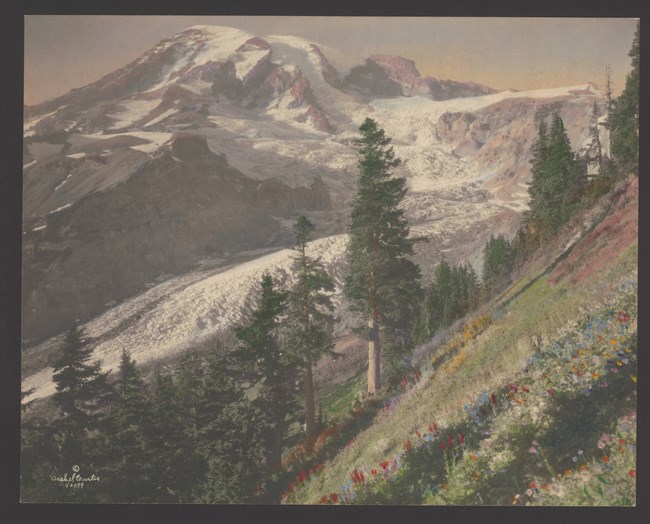
The Inspection Tour
Albright recalled that it was his invitation to Chairman Good to visit Yellowstone that prompted the national park tour. In his 1920 annual report, NPS Director Stephen T. Mather placed the idea for the trip with Good, noting, "At the suggestion of Chairman James W. Good, the committee decided it was in the interests of the Government for them to obtain first-hand information on as many of the national parks as could best be combined with an inspection of various reclamation projects within the scope of a tour of reasonable length." For his part, Good recorded, “The committee, at a meeting Saturday, June 5, determined to accept the invitation of the Interior Department to visit certain of the reclamation projects and national parks.”
Arrangements for the trip were made in 30 minutes after Congress adjourned in early June 1920. Exactly who would attend was unknown almost until they set off two weeks later. Some members brought family with them. The representatives who came on the tour were:
- James W. Good (R-Iowa), chairman of the committee and his wife
- William R. Wood (R-Indiana)
- Louis C. Cramton (R-Michigan) and his wife
- Barton L. French (R-Idaho) and his wife
- Milton W. Shreve (R-Pennsylvania)
- Joseph W. Byrns (D-Tennessee)
- John J. Eagan (D-New Jersey)
- John M. Evans (D-Montana)
- James F. Byrnes (D-South Carolina) and his wife
- James A. Gallivan (D-Massachusetts) and his young son
- Nicholas J. Sinnott (R-Oregon), chairman of the Committee on Public Lands
Other guests and dignitaries were also present for some legs of the trip. Mather had been courting Good, Byrnes, and Byrns (and many other congressmen) for years to win their support for the NPS. Good became committee chairman in May 1919.
The NPS and the Reclamation Service planned the trip, but only the reclamation tour was funded. Mather found ways to support the trip. He secured a 10-compartment Pullman car for the railroad portions of the journey. Officials from the railroad companies traveled with the congressional party over their respective railway lines. Western cities or booster groups visited during the national park inspections paid the expenses for those visits. The park concession companies took care of the party when it was in the parks.
The trip started on June 20, 1920, from Chicago, Illinois, a location considered convenient for most members. They left at 11:30 pm on the Chicago and Northwestern Railway. In addition to the national parks, 11 reclamation projects were inspected, as well as several private irrigation projects or proposed projects. Mather wasn’t available at the start of the tour, so NPS Assistant Director Arno B. Cammerer escorted the party from Chicago to Denver. A.B. Barta, assistant clerk of the House of Representatives, and W.B. Basinger, passenger traffic manager of the Union Pacific, were also on the train. The Reclamation Service’s Director Arthur P. Davis, Assistant Director J.B. Beadle, Chief Engineer F.W. Weymouth, and Assistant Chief Engineer R.F. Walter also traveled with the party.

Rocky Mountain National Park
Many VIPs came out to herald the inspection tour’s arrival in Denver on June 21. In addition to Rocky Mountain Superintendent L. Claude Way, the welcome party at Union Station included:
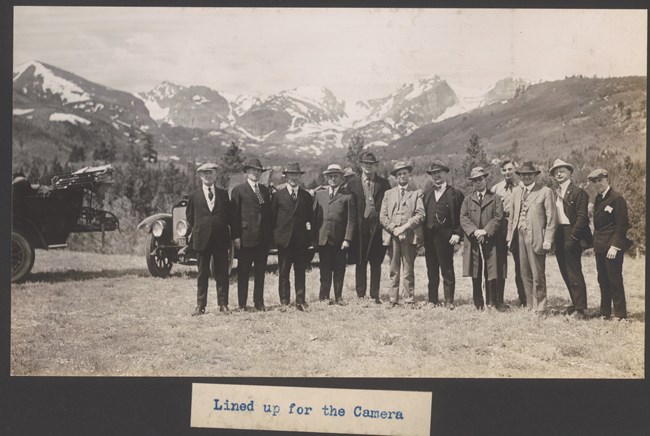
- Colorado Congressmen Edward T. Taylor and Charles B. Timberlake
- Roe Emery, head of the Rocky Mountain Parks Transportation Company
- Warren K. Cundiff, assistant general passenger agent of the Union Pacific in Denver
- Gus Holmes, president of the National Park-to-Park Highway Association
- Scot Leavitt of the Great Falls, Montana, Chamber of Commerce
- Arthur J. Dodge, general manager of the Denver Civic and Commercial Association
- H.B. Tedrow, United States district attorney
- M.D. McEniry, chief of the field division of the United States land office, and
- F.J. Chamberlain and Harry W. Burhans of the Denver Tourist Bureau.
After breakfast at Union Station, they traveled to Estes Park, Colorado, via Loveland and the Big Thompson Canyon. That afternoon they took a ride up Fall River Road in Rocky Mountain National Park. Now known as “Old Fall River Road,” the newly opened road was the first auto route to give access to the park’s high country. The road climbed to Fall River Pass on steep grades, some as high as 16 percent. It also had 16 switchbacks with tight turns. The road itself was generally only 14 feet wide, too narrow for cars to pass safely. Passing places were provided, but they were few and far between. Some were located on switchbacks, making the curves even more difficult to maneuver. The drive would have undoubtedly been memorable for the committee members.
On the morning of June 23, they took a trip up Glacier Basin and visited the free public campground. They also got in some fishing at Sprague Lake. The party lunched with men from Estes Park at the Lewiston Hotel and then returned to Denver. The Denver Tourist Bureau hosted them for dinner that night. Good told them, “We now appreciate the sentiment you have frequently expressed concerning this great park that stands as the gateway to twelve national parks and thirty-two national monuments. It was all so magnificent, so grand, so beyond compare, that words fail in attempting to describe the beauty and charm of this federal playground. The federal parks must be made better known to the world. Let the country know about this magnificent park, where I believe there is the greatest and most beautiful scenery in the entire world. But it must be given publicity, and I’m sure that Congress will appropriate sufficient money for the development of this park and to make its beauties and charms known to the world.” Good also expressed his hope that the privately owned lands within the park boundary would come under NPS control.
Although their visit to the park was brief, one newspaper reported, “The party was enthusiastic over the wonders of their trip and predicted an increased appropriation next year for the development of Rocky Mountain National Park.” Another article in Good’s album reported on the party’s dinner, noting, “open confession was made that the appropriations heretofore had been ‘grossly, beggardly inadequate,’” since the park was established in January 1915.
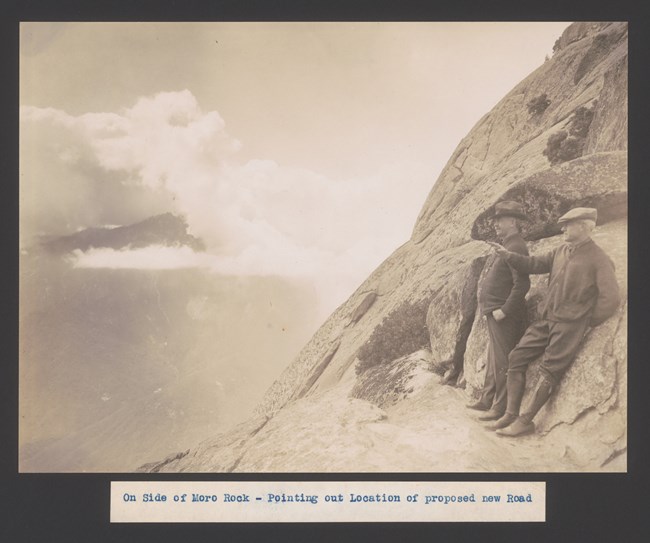
Sequoia National Park
The party spent two days in Oakland, California, being entertained by the chamber of commerce and speaking at luncheons. When they reached San Francisco on June 27, most committee members wanted to stay for the first day of the Democratic national convention. Gallivan left the party in San Francisco to travel to Asia.
Although not part of the official itinerary, Mather appealed to Good to visit Sequoia National Park. On June 28 a small party, consisting of Good, Mather, Ben Maddox and George Stewart from the Visalia Board of Trade (which sponsored the inspection tour), and E.O. McCormick, vice president of the Southern Pacific railroad, made their way to the park. They arrived in the rain at 5 pm. The next morning, they traveled to Moro Rock by car but then “seven or eight miles of trail was covered, the hotel grounds being reached about 12:15 pm. After lunch the General Sherman tree was visited, and later the automobiles were taken on top of a big tree where pictures of the party were made. At 3:40 the trip down the mountain was begun, and the arrival at Visalia was at 8:15.”
The trip was an opportunity to discuss current needs and future plans, including a proposed new road. The Visalia Daily Times noted in a June 30, 1920, article that “the principal object of the trip was to show [Good] how it is proposed to build a new road up the canyon of the middle fork of the Kaweah River to the forest, and also to acquaint him with the development work which must be done in order to make the forest an ideal summer resort for the people of this valley and for the country at large.” After spending the night at the park, Mather and Good left Visalia at 10:10 pm the next evening, after a hastily arranged dinner with the trade board, to rejoin the group in Yosemite Valley.
One uncited newspaper article in Good’s album reported, “There is no question, but that Mr. Good was thoroughly convinced that Giant Forest is one of the greatest assets of this country, and that he will work very closely with Mr. Mather in the future when money is asked for improvements.” Another noted, “Mr. Good was very much pleased with what he saw in the mountains and made some suggestions which he thought should be carried out at the earliest opportunity. He intimated that when future demands were made upon the committee for funds with which to approve the park, that such appeals would meet with a sympathetic understanding.”

On the evening of July 5 Mather left the party briefly to visit Lassen Volcanic National Park. It was his first visit. Congress had recently appropriated $2,500 for the park, it’s first since the national park was created in August 1916.
Yosemite National Park
Newspapers reported that the committee was “looking into the work of the nature guide movement” in Yosemite National Park. A July 21, 1920, article in the Sacramento Bee noted, “The work this year has been supported very largely by Superintendent of National Parks, Mather, who subscribed the amount necessary above the appropriations to carry out the program.” This is just one example of Mather, a wealthy businessman, financially subsidizing the national parks from his own pocket when federal funding wasn’t available.
Photos in Good's album document that the committee visited Mariposa Grove, pausing to have their photographs taken with the Wawona Tunnel Tree and the Grizzly Giant. They also visited the Crane Flat area. Some members of the party climbed to the top of Nevada Falls.
After two days, they traveled to Hetch Hetchy Valley. Following a battle that environmentalists lost, in 1913 Congress approved a plan to dam the Tuolumne River to flood the valley as a water and hydroelectric source for San Francisco. After lunch at Mather Station, the cars were loaded onto the Hetch Hetchy Railroad for transport to the valley. The railroad, completed in 1917, was built by the City of San Francisco to support construction of the 430-foot-tall O’Shaughnessy Dam. The first phase of the dam wasn’t completed until 1923. Photos in Good’s album show the valley before it was flooded.


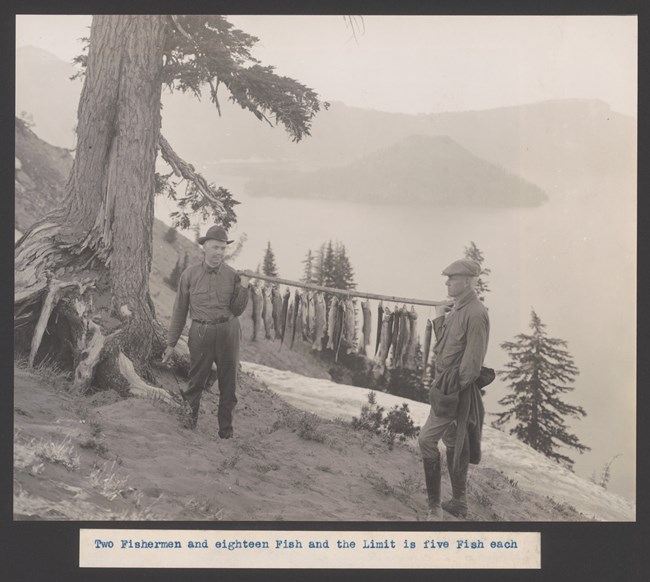
Crater Lake National Park
The committee visited Crater Lake National Park on July 8–9. One of the items on Mather's agenda was to discuss expanding the park to include other scenic features.
Will G. Steel, secretary of the Eugene Chamber of Commerce, reported, “Every member of the congressional party was enthusiastic over the lake and the surroundings. All of them went fishing and there was not a member of the party that did not catch at least a fine rainbow trout.” Steel noted, “while the party was there the surface of the lake was like glass a part of the time and a magnificent reflection of the banks was seen. The weather was fine, and everything tended to make a good impression upon the visitors.”
Although Steel felt “assured that their visit in Oregon will have a strong influence upon the future of national parks and reclamation projects,” the committee “made no statement as to their attitude or their future intentions as to appropriations.”
Mount Rainier National Park
The party arrived in Seattle, Washington, on July 13. They were entertained by city officials before traveling to Tacoma on the morning of July 15. They left for Paradise Valley in Mount Rainier National Park that afternoon and stayed overnight at the Paradise Inn. Snow was still one the ground as they posed for a photograph near the inn. The Rainier National Park Company provided transportation and subsidized their visit.
Although the committee was only in the park overnight, one newspaper account noted, “Important results affecting the future appropriations and development of the [Mount] Rainier National Park are expected.” They committee left the park on July 16. Mather left the party to attend other business after Mount Rainier.

Yellowstone National Park
The party arrived by train to Yellowstone National Park on July 20 for a four-day visit. Superintendent Albright led the party with the support of his rangers and the Yellowstone Park Company. A major concern at the time was a proposal to create a dam on the Yellowstone River at the foot of Yellowstone Lake to support farming. The Yellowstone Irrigation Association proposed to build an 8-foot-high dam that would “submerge 4 or 5 hot springs, of which there were 5,000 in the park” while “making the falls and canyons more beautiful during the months of July and August, the height of the tourist season.” Albright recalled, “I made certain that [the congressmen] got to Yellowstone Lake and heard our story of how proposed dams and irrigation projects would ruin the park. But dam proponents also made sure their side was heard.”
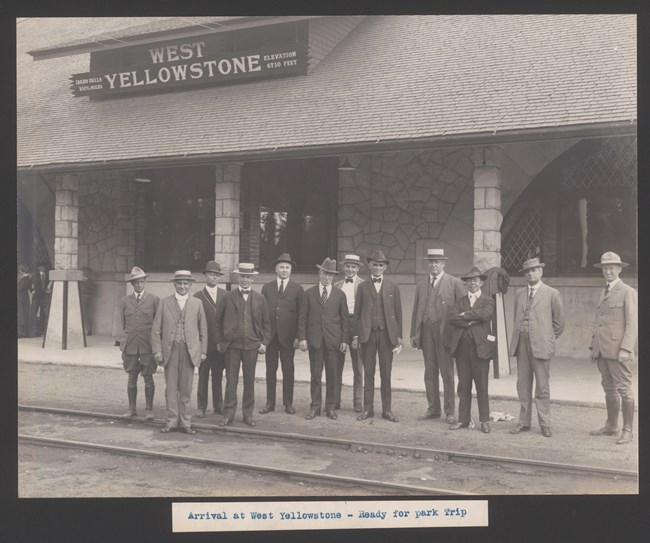
The association presented their plan directly to the congressmen. Afterwards, the Northern Wyoming Herald (Cody, Wyoming) ran an article with the headline “Yellowstone Dam Project Assured.” Representative Evans, however, stated that the committee “would express no opinion, but they had been at the dam site, and they had eyes and used them.”
Funding for park roads was also an important topic of conversation. Publicly the newspapers reported, “During a drive over Mount Washburn in the park today, the committee paid particular attention to the dangerous curves and roadway and discussed the construction of a parapet to prevent cars from leaving the steep grades.” Albright told the “behind-the-scenes” story in a 1969 article:
The roads were in poor condition, and to make the point, I fear I may have had them neglected for a few days before the scheduled visit. Unfortunately, the night before the committee arrived and for two nights following, it rained. Graders had to be used, and the roads were as near perfect as unpaved highways could be—no dust, no "washboard" surface, no ruts. Every day I told my story of the real condition of the roads and the need for money to pave them, but to no avail. On the last day, some member said, "Let's not bring up road improvement, or Albright will start his heart-breaking arguments again!
Good's album documents that during their trip they visited Old Faithful and the geyser basins. Some members also enjoyed fishing. At least one “bear hold up” occurred with a bear approaching the cars for food, which the congressmen provided. This kind of bear interaction was common at the time before the NPS banned the practice for the safety of visitors and protection of bears. The committee was also taken to National Park Mountain, where the national park idea was born around a campfire in 1872.
Albright took some of the party on a side trip to Jackson Lake to impress upon them the advantages of expanding Yellowstone National Park to include that area and part of the Teton Range. Dam proposals at the time were also threatening lakes in the area, including Jenny Lake. Grand Teton National Park was established in 1929 to protect the area.

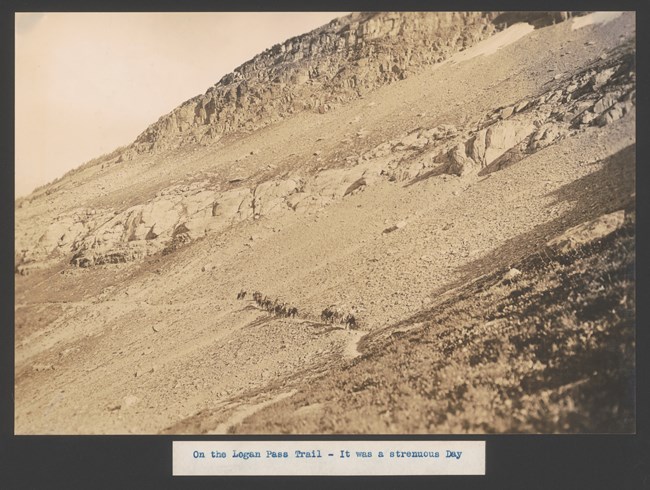
Glacier National Park
From Yellowstone the committee went to Glacier National Park, arriving July 28. Acting Superintendent George E. Goodwin escorted the committee. Members of the chamber of commerce lobbied the committee for a lower route for the Glacier to Belton road through the park, rather than the planned road through Logan Pass.
Although their visit only lasted two days, Good's album shows that the congressmen saw a lot of the park. They posed for photographs with unidentified Blackfeet Indians in front of the Glacier Park Hotel, the first hotel built by the Great Northern Railway. Unfortunately, no records of any conversation between the two groups have been found. The photo caption in the album (not included here) reflects the paternalistic and racist views of the 1920s. The committee also traveled up Logan Pass on horseback and stayed at the Going-to-the-Sun chalets. They visited Lake McDonald, canoed on Two Medicine Lake, and took a boat tour on St. Mary Lake. They saw Grinnell Glacier and Garden Wall from Josephine Lake trail.
Glacier was the last national park visited during the 1920 trip. The committee visited more reclamation sites before beginning their return trip to Washington, DC. Overall, the Appropriations Committee's trip lasted 42 days. During that period, the party traveled 7,000 miles by train and boat, and almost 2,500 miles by car.

Lasting Effects
After completing the inspection tour, Chairman Good wrote to Mather about the success of the trip:
The committee has had a wonderful trip. I was prepared in some degree for the grandeur of the scenery and the many wonderful attractions which the parks afford, but I was not prepared for the splendid service which is afforded persons who are permitted to visit the parks. I can not [sic] too strongly commend your entire plan. I am strongly impressed with your entire organization and with the high character of the men whom you have brought into the service, not only as superintendents but as rangers. Certainly they are not attracted by the salaries they receive. So, too, the concessionaries of the parks seemed to be actuated not so much by the profits that may be realized from the parks. Considering the fact that the parks are open during a very small portion of the year and that efficiency in any service can only be obtained by continuous work in building up an organization and weeding out the undesirable, I am very greatly pleased with the entire park service. You certainly are to be congratulated upon a very great accomplishment with respect to the entire park management.”
Mather noted in his 1920 annual report that "Of great importance to the development of our parks was the visit of members of the Committee on Appropriations of the House of Representatives to some of the northern parks during June, July, and August of this year. With the exception of one member, none of the present committee had had the opportunity to visit our national playgrounds for which they were annually asked to appropriate federal funds."
The trip created NPS supporters of several key congressmen, including Louis C. Cramton who served in Congress until 1931 and then became a special assistant to the secretary of Interior for a year. NPS budgets increase during the 1920s, a crucial time for the new bureau as post-war travel and an increase in private car ownership brought more visitors to "the national playgrounds."
Sources:
-- (1920, June 20). “Congressmen to Tour Parks.” San Francisco Examiner (San Francisco, California).-- (1920, June 21). “Congressmen Start on Junket to Beauty Spots of America.” The Sun (Baltimore, Maryland), p. 2.
-- (1920, June 28). “Visitors Here to See Gian Forest.” Visalia Daily Times (Visalia, California).
-- (1920, June 29). “Pay Visit to National Park.” The Republican (Fresno, California).
-- (1920, June 30). “Chairman of Appropriations Committee of Congress Sees National Park Requirements.” Visalia Daily Times (Visalia, California).
-- (1920, July 2). “Congressional Party Visits Rocky Mountain National Park.” Accessed April 2, 2023, at https://eparkhives.com/pdf/1920-Trail-Talk.pdf
--(1920, July 5). “Tacoma Invites All Delegates.” The Tacoma Daily Ledger (Tacoma, Washington), p. 2.
-- (1920, July 7). “Congressmen Arrive a Day Ahead of Time.” The Evening Herald (Klamath Falls, Oregon), p. 1.
-- (1920, July 10). “Congressmen Go on Oregon Lands to be Reclaimed.” The Oregon Daily Journal (Portland, Oregon), p. 2.
-- (1920, July 12). “Congressmen will Boost Crater Lake.” The Eugene Guard (Eugene, Oregon), p. 1.
-- (1920, July 12). “21 Congressmen in Tacoma Today.” The Tacoma Daily Ledger (Tacoma, Washington), p. 1.
-- (1920, July 13). “Larger Appropriation for Lake is Expected.” The Morning Register (Eugene, Oregon), p. 2.
-- (1920, July 21). “Appropriation Committee Inspects Yellowstone Park.” The Missoulian (Missoula, Montana), p. 6.
-- (1920, July 21). “Federal Committee Visits Yosemite to Investigate Study.” The Sacramento Bee (Sacramento, California), p. 21.
-- (1920, July 28). “Congressional Appropriations Committee Given Hearty Welcome by Members of Cody Club.” The Northern Wyoming Herald (Cody, Wyoming), p.1.
-- (1920, July 28). “Yellowstone Dam Project Assured.” The Northern Wyoming Herald (Cody, Wyoming), p.1.
-- (1920, July 30). “Congressmen Enjoy Glacier Park Trip.” Great Falls Tribune (Great Falls, Montana), p. 9.
-- (1920, July 30). “Take Up Park Road with Committee.” The Daily Inter Lake (Kalispell, Montana), p. 3.
-- (2001, May 10). “James W. Good Jr., 90.” The Chicago Tribune (Chicago, Illinois). Accessed April 1, 2023, at https://www.chicagotribune.com/news/ct-xpm-2001-05-10-0105100306-story.html
Albright, Horace M. (1969, September). “Harding, Coolidge, and the Lady Who Lost Her Dress.” The American West, Vol VI, No 5, pp. 25-32. Accessed on April 1, 2023, at http://npshistory.com/newsletters/the-american-west/v6n5.pdf
Albright, Horace M. as told to Robert Cahn. (1985). The Birth of the National Park Service: The Founding Years, 1913-1933. Howe Brothers, Salt Lake City, Utah.
James W. Good Album (HFCA 1826), NPS History Collection, Harpers Ferry, WV.
National Park Service. (1920). Report of the Director of the National Park Service to the Secretary of the Interior for the Fiscal Year Ended June 30, 1920, and the Travel Season 1920. Government Printing Office, Washington, DC.
National Park Service. (2015, July 14). “Old Fall River Road.” Accessed April 2, 2023, at https://www.nps.gov/romo/planyourvisit/old_fall_river_road.htmShankland, Robert. (1970). Steve Mather of the National Parks. Alfred A. Knopf, New York.
Tags
- crater lake national park
- glacier national park
- mount rainier national park
- rocky mountain national park
- sequoia & kings canyon national parks
- yellowstone national park
- yosemite national park
- nps history
- nps history collection
- hfc
- congress
- appropriations
- appropriations committee
- museum archives
- photographs
